8+ Sample Short Sales Proposal
-
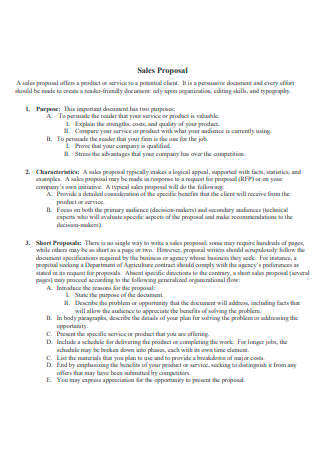
Short Sales Proposal Template
download now -
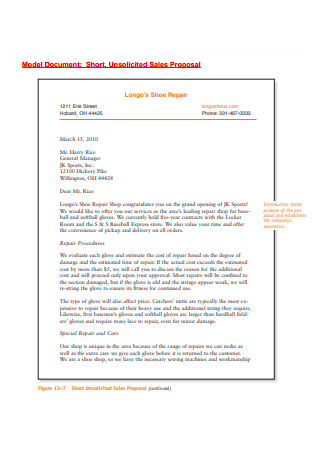
Basic Short Sales Proposal
download now -
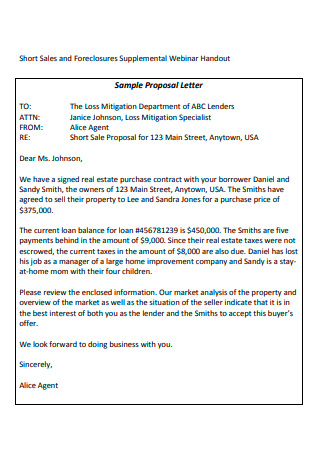
Short Sales Proposal Letter
download now -
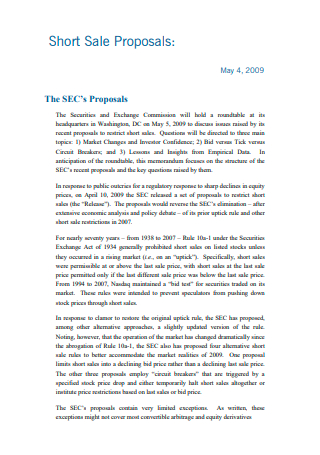
Short Sales Proposal Example
download now -
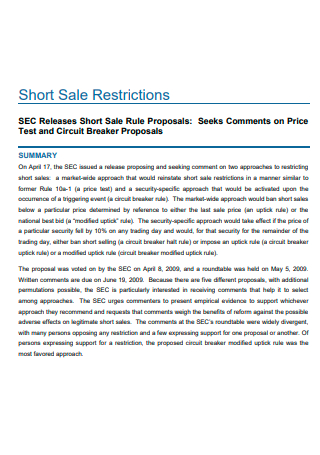
Short Sale Restrictions Proposal
download now -
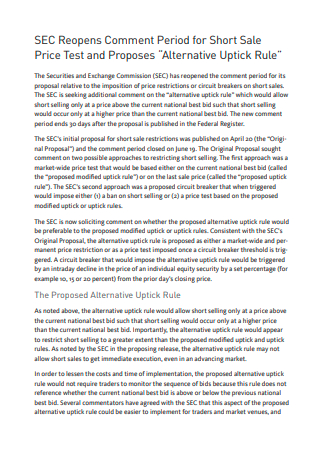
Short Sales Proposal in PDF
download now -
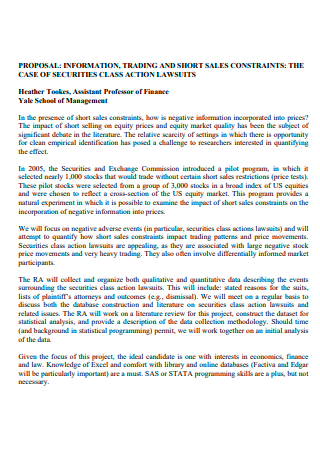
Short Sales Constraints Proposal
download now -

Short Sales Price Test Proposal
download now -
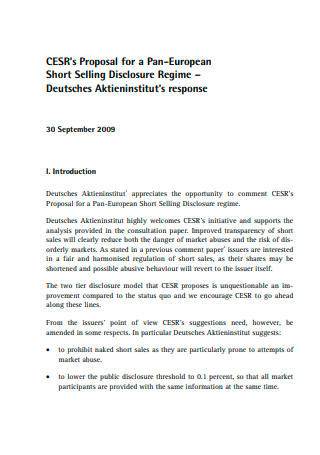
Printable Short Selling Proposal
download now
FREE Short Sales Proposal s to Download
8+ Sample Short Sales Proposal
a Short Sales Proposal?
Elements of a Sales Proposal
Tips in Writing a Creative Sales Proposal
How To Write a Short Sales Proposal
FAQs
What is the purpose of a sales proposal?
What do you mean by elegant fonts?
How should a proposal be formatted?
What Is a Short Sales Proposal?
A short sales proposal is a document used by an individual or corporation to sell their services or products to prospective clients and customers. They are also known as business proposals, project proposals, and executive summaries. Sales teams can use short sales proposals, consultants, agencies, and anybody else to demonstrate how their offerings benefit their target market. Nearly 400 salespeople gain powerful insight into today’s selling world: how it’s changing, what it means for them in the field, and how to excel. According to data, at least 50% of your prospects are not a good fit for what you sell. 71.4% of respondents indicated that less than half of their initial prospects are a suitable fit.
Elements of a Sales Proposal
A sales proposal is frequently a formality—the buyer has already decided whether or not to purchase. At other times, a sales pitch is critical. All purchasers’ decision-makers and influencers will assess it. Because you never know for sure whether your proposal will be a formality, you should write it as if the sale is at stake. While a polished proposal is never excessive, one that is poorly put together may dissuade you from placing an order. Here are five elements that should be in your sales proposal to make it more persuasive and impactful.
Tips in Writing a Creative Sales Proposal
Successful sales require successful proposals, which is why the ability to draft a winning sales proposal is a critical talent for any sales team to possess. A strong recommendation can mean the difference between securing agreements, gaining additional business, and eventually growing your business or remaining static. Gaining clients and establishing new long-term relationships is critical in the present economic climate, so how can you prepare an effective sales proposal? We’ve listed down some essential factors to consider while writing a sales proposal. Whether you’re creating a cover letter for a sales proposal, giving a business proposal in person, or starting a written sales proposal plan, these recommendations can help you produce an outstanding sales proposal and capitalize on those critical new business prospects.
1. Conduct research
Before you even begin writing your sales proposal letter, you should spend some time studying your target audience—conduct market research on your prospective client’s customers, as well as competitive analysis. The more research you conduct, the more effectively you can demonstrate how your products and services meet their demands. According to a recent study, 79% of consumers prefer to deal with salespeople who are trusted advisors who can bring value to their business. Therefore, it pays to be as knowledgeable as possible about your prospects’ needs to demonstrate how to provide value to their business.
2. Maintain a practical and personable tone.
It’s not enough to claim that your products and services can help a company address problems; you must show how they can. Maintaining a laser-like focus on the practical application of your product or service will be critical in convincing any potential clients that you are the best fit for them. Making sure you tailor to your business prospect is a crucial component of this. It may be intriguing to copy and paste from a previous proposal or find an example sales proposal letter online. Still, if this is clear, the client will not feel as if they are receiving an authentic and personalized sales experience. Instead, treat the proposal as a tool for establishing a new business connection, and make it as specific and personal as possible. After all, companies that use personalization approaches currently receive a 19 percent gain in revenue on average.
3. Be direct.
Nobody likes being stung by hidden fees or charges, especially in business, so if you’re serious about developing long-lasting beneficial relationships, ensure that all prices are disclosed. While it may be tempting to offer discounted starting pricing, you should always ensure that any written proposals include your total list price. Thus, by specifying the amount prospective new clients are likely to pay, you may establish financial expectations, convince prospects that they are being billed correctly, and minimize additional damage to the relationship. This includes disclosing fees and penalties for late payments.
4. Maintain simplicity
Avoid corporate jargon at all costs — according to a recent study, up to 24% of office workers are irritated by the usage of buzzwords and phrases such as “touch base,” “no-brainer,” and “game-changer.” While you want to make your proposal as accessible and intelligible as possible, this does not require you to dumb it down. Utilize explicit wording whenever possible. Concentrate on active verbs, omit lengthy explanations, and emphasize direct persuasion and participation.
How To Write a Short Sales Proposal
Sales proposals are a critical component of the deal-closing process. Yet far too frequently, sales organizations cannot craft winning sales proposals, resulting in missed opportunities. Whether you’re a novice or a seasoned salesperson, applying the following strategies to your presentations can help you avoid costly errors and boost your sales game.
Step 1 Be succinct
The lengthier your proposal, the less likely it is that your prospect will read it all the way through. To be sure, people have limited attention spans and will not trudge through a thick proposal. Therefore, keep your suggestion brief and direct. A standard proposal should be between eight and twenty pages in length. While others say that one or two pages are sufficient, this length may not be feasible for many transactions. The appropriate size of your proposal will vary according to your business, client, and offer. The trick is to maximize the impact of each word. Look for opportunities to modify, condense, or eliminate. Once the fat is removed and the wording is polished, you’ll have a better, more persuasive presentation to present.
Step 2 Individualize your template.
Utilizing templates can assist your team in saving time and ensuring uniformity. On the other hand, if you’re copying and pasting the same boilerplate information into each proposal, you’re missing out on an opportunity to meet with your prospect. Effective selling is not about you. It all comes down to your competitor. Everyone desires to be heard and appreciated. Customizing your proposal is a straightforward method to demonstrate to prospects that you understand their needs. Customize the presentation to the unique client as you create your submission. While some material will be nearly identical across offers, there are numerous opportunities to customize the request. Concentrate on their issue. Explain to them that you understand their problem better than anybody else, and then explain how you can help them solve it as well. Your proposal will be more successful and persuasive if it is more personalized.
Step 3 Concentrate on resolving issues, not on delivering deliverables
One of the most common mistakes salespeople make is to focus only on the deliverables of the product or service rather than on the prospect’s problem. Bear in mind that selling is not about you. It is a matter of them. Emphasize your comprehension of the challenges they’re attempting to solve in your proposal, and then illustrate why your solution is the best method to handle those difficulties. This is far more persuasive than a laundry list of features and benefits to a prospective consumer. If you fail to relate those benefits to the client and their unique problem spots, you are forcing them to undertake the job of determining how your solution will benefit them. And that is a surefire way to lose a transaction.
Step 4 Provide them with alternatives.
Historically, proposals included only one solution. However, if you do not present different options, you may be losing money. Propose three solutions at varying pricing points for the most outstanding results. This technique benefits you since it enables you to choose rates, including a premium tier. Additionally, by providing various possibilities inside a single proposal, you reduce the likelihood that your prospective client will shop around with your competition. This makes you your competitor, resulting in a win-win situation for you. Also, when prospects had options, they were better satisfied with their final decision since they had more information and context to work with. Indeed, simply providing customers with a comparison of options at various price points frequently results in negotiations at a premium price. By balancing each solution against a range of price points, the prospect can better understand the value of the answers you’re presenting and increase their confidence in the one they choose.
Step 5 Order costs ranging from high to low
If you’re proposing, the likelihood is that your solution involves enterprise-level prices, which means that even your most reasonable offer may cause initial sticker shock for your prospect. One method is to rank your price points from highest to lowest to avoid scaring people away. You prevent exacerbating an early bad reaction by beginning with the most expensive option and gradually decreasing it. On the other hand, if you start inexpensive and progressively increase the price of your solutions, the prospect may become progressively protective. While this psychological tactic is straightforward, it can go a long way toward developing favorable responses to your idea.
Step 6 Utilize visuals.
Take advantage of this. Utilize appropriate graphics, such as graphs, project flowcharts, or tables to show data and simplify complex concepts. These visualizations may include diagrams depicting the current and future states, a project roadmap, or paperwork outlining the steps necessary to implement a solution. Bear in mind that whatever visuals you employ should appear professional and consistent with your brand. Color schemes, typefaces, and images should be coordinated to make your presentation more unified and your firm seems more capable and respectable.
FAQs
What is the purpose of a sales proposal?
Successful sales presentations persuasively argue for an understanding of the potential customer’s problem and why your organization is the best choice to solve it – ultimately resulting in a closed agreement. However, even the best solutions can be rejected due to a weak pitch if they lack a solid and compelling sales proposition.
What do you mean by elegant fonts?
An elegant typeface is one that immediately conveys a sense of formality, classicism, or luxury. Typically, the majority of these lovely fonts are script and handwritten types or are inspired by calligraphy.
How should a proposal be formatted?
A proposal typically includes A brief description of the problem, solution, expenses, and benefits in the introduction. Subject, purpose, primary argument, background information, and importance are all part of the issue’s primary definition.
The appropriate sales proposal can help you reach more clients, gain more power, and raise your company’s revenue. Ascertain that you utilize this feature to its full potential and maximize your sales by developing significant proposals that capture the reader’s attention. Create one right now by using our templates above!
